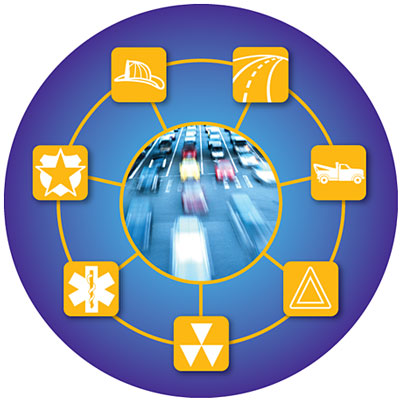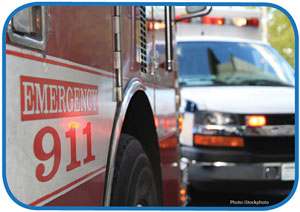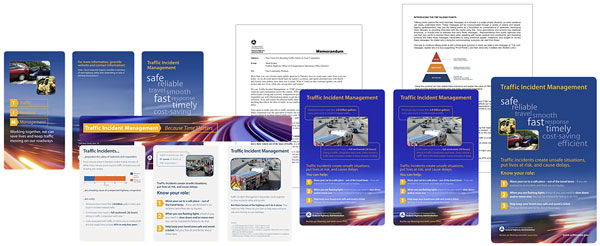Traffic Incident Management Outreach Toolkit:
Master PowerPoint Presentation
Printable Version [PDF 1.72MB]
PowerPoint Version [PPT 7.01MB]
PDF files can be viewed with the Acrobat® Reader®.
PPT files can be viewed with the Microsoft PowerPoint Viewer.
slide 1
Traffic Incident Management
safe, reliable, travel, smooth, fast, response, timely, cost-saving, efficient

slide notes
When we speak with the men and women who come to our rescue in traffic crashes and other traffic incidents on our roadways, we learn that one group at the scene whose response can be equally critical actually to saving lives of both motorists and on-scene responders.
That group is us - motorists.
The better motorists understand the risks associated with traffic incidents on roadways, they more likely they are to be more of the solution.
The behavior of motorists involved in an incident, or passing by an incident scene—can make the difference between life and death, and between safety and injury, not to mention lower body shop bills.
Specifically, motorists need to know to #1) SLOW DOWN and MOVE OVER to an adjacent lane when they see flashing lights and #2) to MOVE THEIR VEHICLE out of travel lanes if they are involved themselves in any kind of traffic incident, and it is safe and possible to do so.
slide 2
Pop Quiz!
Match the numbers on the following slide to these facts!
Do you know?
Number of law enforcement officers killed being struck by a vehicle since 2000
Gallons of fuel wasted by Americans idling in incident-related traffic
Number of minutes added to traffic delay for every minute a lane is blocked due to a traffic incident
Number of hours the average American commuter spends idling in traffic every year
Percent jump in costs associated with traffic incidents over past 4 years.
Number of responders in harm's way at an incident scene on any given day
Average number of responders (police, fire, EMS, tow truck drivers, and transportation/maintenance workers) injured every year responding to a traffic incident
slide notes
[MATERIALS NEEDED: HANDOUT—SEE FINAL SLIDE FOR OPTIONAL HANDOUT]
Nobody likes pop quizzes but this one will capture your attention.
On your worksheet, take a stab at matching the numbers you see on the next screen (and also on the sheet) to the facts in the right column. Let's see how we do!
[INSTRUCTOR NOTE: Give about 5 minutes for this, but watch the audience and give any additional time as needed]
slide 3
Pop Quiz!
87.2B, 36, 4, 38,000, 20,000, 24, 160+ 2.8B
slide notes
None.
slide 4
Answer Key
| Fact | Answers |
|---|---|
| 160+ | Number of law enforcement officers killed being struck by a vehicle since 2000 |
| 2.8B | Gallons of fuel wasted annually by Americans idling in incident-related traffic |
| 4+ | Number of minutes added to traffic delay for every minute a lane is blocked due to a traffic incident |
| 36 | Number of hours the average American commuter spends idling in traffic every year |
| 85 | Percent jump in costs associated with traffic incidents over past 4 years. |
| 38,000 | Number of responders in harm's way at an incident scene in a 24-hour period |
| 20,000 | Average number of responders (police, fire, EMS, tow truck drivers, and transportation/maintenance workers) injured every year responding to a traffic incident |
slide notes
[WALK THROUGH EACH FACT, AND ALLOW SOME INTERACTION WITH PARTICIPANTS—INVITE PEOPLE TO OFFER UP THEIR BEST GUESS ANSWERS—MAKE IT FUN!]
- 160+ law enforcement officers struck and killed by a vehicle since 2000 (and this number is higher by 2012). Source: National law enforcement database, 2010
- 2.8B gallons of fuel wasted annually by Americans idling… Source: Cambridge Systematics, Inc. 2011. Crashes vs. Congestion: What's the Cost to Society? Bethesda, MD: AAA Foundation.
- 4 minutes added to traffic delay for every minute a lane is blocked. Source: Oregon DOT, 2012 (and they estimate 4-6, so this is conservative!)
- 36 hours are wasted every year sitting in traffic queues by the average American. Source: U.S. DOT Strategic Plan FY 2010 – FY2015; April 15, 2010
- 85% jump in incident related costs… Source: AAA, 2012
- 38,000 responders are in harm's way… Source: Emergency Responder Institute. Estimate based on number of injury crashes per minute; and typical number of emergency responders to injury crashes. This number is conservative and actually much higher as non-injury crashes also require response, as do fatal crashes:
It is estimated that there are approximately three injury crashes every minute. This translates to 1,620 responders working in or near moving traffic every hour or 38,880 responders potentially in harm's way in a 24-hour period based on a typical response. A typical response might include: two law enforcement responders, four fire department responders, two EMS responders, and one tow truck operator, for a total of nine responders.
AUDIENCE ENGAGEMENT:
Reactions? Did you already know these facts related to traffic incidents? What surprised you in these facts?
Average number of Responders struck and killed each year while working in or near moving traffic: Fire/Rescue and EMS: 6 to 8, Law Enforcement: 10 to 12, Towing/Recovery: 50, Highway: 100, with more than 20,000 injured.
slide 5
So what is a "traffic incident" anyway?
slide notes
AUDIENCE ENGAGEMENT:
Can anyone tell me what a ‘traffic incident’ is?
(INSTRUCTOR NOTE: Generate multiple answers, use a flip chart or white board if one is available. Collect all answers. Probe for an exhaustive list)
slide 6
Traffic Incidents

Photo: iStockphoto
Traffic incidents are just about anything that happens on or near a roadway that affects traffic.
- They create unsafe situations and put lives at risk, and cause delays.
- They compromise our safety, and cost us time and money everyday.

slide notes
All of these answers are correct.
- Traffic incidents are just about anything that happens on or near a roadway that affects traffic. This includes everything from the serious crash or overturned truck, to the tire change on the side of the road.
[INVITE AUDIENCE ENGAGEMENT]
So, why should we care about traffic incidents? What's the big deal? What do you think are some of the implications of traffic incidents on our lives and the quality of our lives overall in terms of the roadways?
Answers:
- Traffic incidents create unsafe situations for other people on the road, and put motorist and responder lives at risk and cause delays.
- As you can see from this figure—you can almost imagine it as a traffic lane!—Every minute a freeway lane is blocked creates four extra minutes of delay, and this is conservative as some regions estimate closer to six minutes of delay (Oregon DOT).
This matters because incident-related traffic delay creates additional safety hazards to motorists: Your risk of being hit from behind by an inattentive driver increases every minute you're stuck in traffic jam. Traffic jams make it more difficult for responders to provide the life-saving help people need when they are in a crash. Time matters: Traffic jams are not only frustrating and gas guzzling, they can be dangerous.
- Traffic incidents compromise our safety, cost us valuable time and money everyday.
- So we all have a stake in the safe and quick clearance of traffic incidents from our roadways.
slide 7
Who Responds to Traffic Incidents?
slide notes
[AUDIENCE ENGAGEMENT]
OK, so raise your hand if you've NEVER been in a traffic incident.
[The audience will likely laugh here—the point is that more than likely every one of us at one time or another has been in a traffic incident. At a minimum, we have all passed traffic incidents on freeways.]
What kinds of people respond to a traffic incident? Who all is involved?
[NOTE: this is a setup—Spend a few minutes here but not too long. Participants will most likely begin by naming different types of responders. Allow them to build the list in a few minutes and then move on and quickly touch on the next slide. The punch line that ultimately follows—and the major take-home message of the presentation is that WE ALL have a role.]
[Collect answers from the group-there are likely no "wrong" answers, and most likely no single person knows ALL of the answers, which is the point of this engagement—to illuminate the full spectrum of responders involved in Traffic Incident Management, and to instill the appreciation that these different professions work together to help keep our roadways safe and clear.
This is a prelude to the importance of the public recognizing that THEY TOO have an important role—which is to Slow Down and/or Move Over whenever they see flashing lights, and to move their vehicle out of the lanes of traffic if they are involved in any kind of traffic incident if there are no injuries and the vehicle can be driven.]
slide 8
Traffic Incident Management Helps Everyone
- Traffic Incident Management
Responders work together as a team to respond safely and quickly.- Firefighters
- Law enforcement officers
- EMS responders
- Transportation/Safety Service Patrols
- Maintenance crews
- Towing and recovery
- 911/Dispatch

Photo: Shutterstock
slide notes
[TOUCH ON THIS SLIDE BUT DO NOT DWELL—It is a prelude to the next slide]
- Traffic Incident Management responders work closely together as a team to clear incidents safely and quickly.
- Towing and recovery professionals are key members of TIM, helping move cars and trucks out of roadways.
- With Traffic Incident Management, firefighters, EMS, law enforcement, towing and recovery, safety patrols, transportation and maintenance crews and 911 professionals work together using well-rehearsed procedures to respond quickly and safely.
This figure just shows the array of responders who work together.
NOTES:
- ALL stakeholders mentioned by the audience may not have been mentioned, but these are the primary responder stakeholders.
- Beginning with the fire hat and moving clockwise, responder groups are: Fire, transportation/maintenance crews and safety service patrols, towing and recovery, 911 dispatch, hazardous materials experts, EMS responders and law enforcement.
slide 9
Traffic Incident Managers Can't Do It Alone!

Photo: iStockphoto
slide notes
TIM responders are the heroes of our highways, saving lives everyday. They work together to make sure the right people show up on the scene.
BUT THEY CAN'T DO IT ALONE. THEY NEED OUR HELP
slide 10
Do Your Part!
What You Need to Know
- Move your car to a safe place – out of the travel lanes – if you are involved in an incident, and there are no injuries.
- When you see flashing lights ahead of you, you need to slow down and/or move over. You can be ticketed for failing to do this!
- Help keep your loved ones safe and avoid a ticket. Tell your friends and family about these laws.
slide notes
[AUDIENCE ENGAGEMENT]
Which of these is required by law in most states? (Answer: #1 and 2)
[EDUCATE HERE ABOUT YOUR STATE'S LAWS—
VISIT http://www.respondersafety.com/MoveOver.aspx TO ACCESS A LISTING OF TRAFFIC INCIDENT-RELATED LAWS AND POLICIES BY STATE. YOU ARE ENCOURAGED HOWEVER TO CHECK YOUR STATE TRAFFIC CODE AND/OR DEPARTMENT OF MOTOR VEHICLES TO CONFIRM.]
Which of these should you do in every state? (Answer: ALL)
By moving our vehicles out of the lanes of traffic if we safely can when we are involved in a traffic incident
- We are helping to keep ourselves and others safe by moving out of the lane of traffic
- We are helping to keep traffic moving on our roadways
- We are helping to reduce emissions.
By slowing down and/or moving over when we see flashing lights
- We are helping to protect lives of responders and people in the traffic incident.
- Responders and other motorists are safe when drivers move over, and/or slow down to give them space. They are able to provide the right help faster to those in need and open the roadways more quickly.
slide 11
Pop Quiz!
- What's a traffic incident?
- What should you do with your vehicle—if you safely can—if you are in a traffic incident?
- What should you do when you see flashing lights on a roadway?
- What should you do when you leave this room today?
slide notes
[INSTRUCTOR NOTE: Give about 5 minutes for this quick closing quiz]
ANSWERS:
What's a traffic incident?
Anything that affects conditions on a roadway.
What should you do with your vehicle, if you safely can, if you are in a traffic incident?
MOVE IT out of the lanes of traffic
What should you do when you see flashing lights on a roadway?
SLOW DOWN and/or MOVE OVER
What should you do when you leave this room today?
Tell everyone you know about these laws.
slide 12
How Can I Help?
You can help spread the word in your community using the Traffic Incident Management Public Outreach Toolkit Products. They are freely available and customizable:

https://ops.fhwa.dot.gov/tim/timtoolbox/
slide notes
None.
slide 13
OPTIONAL HANDOUT: POP QUIZ!
Match the numbers in the left column to the fact in the right column
| Fact | Answers |
|---|---|
| 85 | Number of law enforcement officers killed being struck by a vehicle since 2000 |
| 160+ | Gallons of fuel wasted annually by Americans idling in incident-related traffic |
| 2.8B | Number of minutes added to traffic delay for every minute a lane is blocked due to a traffic incident |
| 38,000 | Number of hours the average American commuter spends idling in traffic every year |
| 36 | Percent jump in costs associated with traffic incidents over past 4 years. |
| 20,000 | Number of responders in harm's way at an incident scene in a 24-hour period |
| 4+ | Average number of responders (police, fire, EMS, tow truck drivers, and transportation/maintenance workers) injured every year responding to a traffic incident |
slide notes
None.
slide 14
Questions?
<National statistics are used in this presentation. Presenters are encouraged to complement these with regional or more localized information if possible.>
slide notes
[TAKE ANY QUESTIONS AND NOTE ANY CLOSING OBSERVATIONS FROM PARTICIPANTS].
TO THE PRESENTER:
HOW'D IT GO? PLEASE LET US KNOW HOW WE CAN FURTHER ASSIST YOU IN RAISING AWARENESS ABOUT THESE IMPORTANT SHARE FEEDBACK FROM YOUR SESSION WITH THE FEDERAL HIGHWAY ADMINISTRATION'S EMERGENCY TRANSPORTATION OPERATIONS TEAM BY EMAILLING [INSERT EMAIL]
slide 15
Thank you!

slide notes
None.